

Bluetooth Sniffing using Wireshark & nRF52 DK Board. This section shows how to setup a tool for sniffing of Bluetooth protocol and learn about the Bluetooth devices through reverse engineering of the Bluetooth protocol.
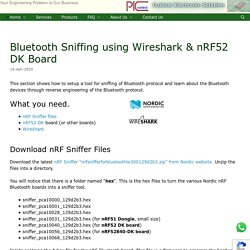
Download nRF Sniffer Files Download the latest nRF Sniffer “nrfsnifferforbluetoothle300129d2b3.zip” from Nordic website. Unzip the files into a directory. You will notice that there is a folder named “hex“. This is the hex files to turn the various Nordic nRF Bluetooth boards into a sniffer tool. sniffer_pca10000_129d2b3.hexsniffer_pca10001_129d2b3.hexsniffer_pca10028_129d2b3.hexsniffer_pca10031_129d2b3.hex (for nRF51 Dongle, small size)sniffer_pca10040_129d2b3.hex (for nRF52 DK board)sniffer_pca10056_129d2b3.hex (for nRF52840-DK board)sniffer_pca10068_129d2b3.hex Inside contains the *.hex file for the nRF Bluetooth board. It also contain some script program plugin for Wireshark software to work seamlessly with the nRF sniffer hardware.
Android - One bluetooth device with multiple apps. 4. GATT (Services and Characteristics) - Getting Started with Bluetooth Low Energy. Chapter 4.
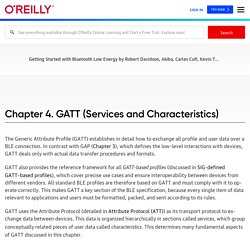
GATT (Services and Characteristics) The Generic Attribute Profile (GATT) establishes in detail how to exchange all profile and user data over a BLE connection. In contrast with GAP (Chapter 3), which defines the low-level interactions with devices, GATT deals only with actual data transfer procedures and formats. Introduction to Bluetooth Low Energy. Bluetooth 5 Advertisements: Everything you need to know - Novel Bits. * Copyright (c) 2015 - 2017, Nordic Semiconductor ASA * All rights reserved. * Redistribution and use in source and binary forms, with or without modification, * are permitted provided that the following conditions are met: * 1.
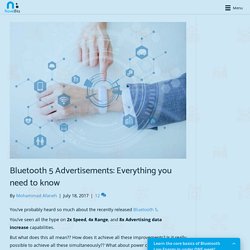
Redistributions of source code must retain the above copyright notice, this * list of conditions and the following disclaimer. Nordic Semiconductor - Introduction to Bluetooth Smart. Bluetooth® Low Energy Security Modes and Procedures - Developer Help. Along with the previously outlined Bluetooth® Low Energy (BLE) Generic Access Profile (GAP) Discovery/Connection Modes and Procedures, GAP also defines modes and procedures for security establishment and enforcement.

These modes and procedures build upon rules and algorithms implemented in the Security Manager (SM) layer. A BLE connection is said to operate at a specific security mode. Within each mode are several security levels. The required security mode/level of a connection may change from time to time, leading to procedures to increase that level. Each connection starts its lifetime in Security Mode 1, Level 1 (see below). To keep it simple, when two devices which initially do not have security, wish to do something which requires security, the devices must pair first. The new security level of the connection is based on the method of pairing performed and this is selected based on the I/O capabilities of each device. Bluetooth Basics. Favorited Favorite 31 What is Bluetooth? Bluetooth is a standardized protocol for sending and receiving data via a 2.4GHz wireless link. It's a secure protocol, and it's perfect for short-range, low-power, low-cost, wireless transmissions between electronic devices.
These days it feels like everything is wireless, and Bluetooth is a big part of that wireless revolution. You'll find Bluetooth embedded into a great variety of consumer products, like headsets, video gamecontrollers, or (of course) livestock trackers. In our world of embedded electronics hackery, Bluetooth serves as an excellent protocol for wirelessly transmitting relatively small amounts of data over a short range (<100m). Blocking - How to block bluetooth signals?
Bluetooth 5 & BLE: Achieving maximum throughput and speed. Introduction In this second post in the series on Bluetooth 5, we cover the new feature of improved 2x speed along with a general overview of throughput for a BLE application (the previous post went over Bluetooth 5’s new features in general and more specifically covered the increased advertisement capacity feature).
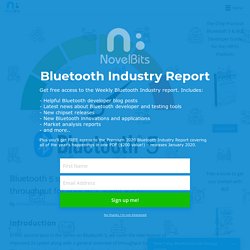
First, we need to understand that the speeds advertised (1 Mbps and the new 2 Mbps) are only theoretical and are cut down when it comes down to application throughput. This is due to multiple reasons which we’ll go over in the next section. The Bluetooth 5 “2x speed” feature requires a hardware update so older devices/chips/modules will not support it.
Nordic tutorials. 5 Essential Tools for EveryBluetooth Low Energy Developer. Mohammad Afaneh of NovelBits shares his recommendations One of the biggest challenges of learning any new technology is knowing which tools you need to get started.

iOS 8 disconnection: Code=6 "The connection has timed out unexpectedly." Bluetooth Technology Website. BLE notify on ESP32 controller - OpenLabPro.com. BLE standard defines two ways to transfer data for the server to the client: notification and indication.

Notifications and indications are initiated by the Server but enabled by the Client. Notification doesn’t need to be acknowledged, so they are faster and an efficient way to read data continuously. Hence, a server does not know if the message reaches to the client. Indication needs to be acknowledged for communicating. The client sent a confirmation message back to the server, this way server knows that message reached the client. The server is not able to send indications or notifications at the beginning of the communication. Code snippet The libraries used here are Define service UUID and characteristics UUID. How to connect to BLE devices. This guide shows you how to connect to Bluetooth Low Energy devices from JavaScript.
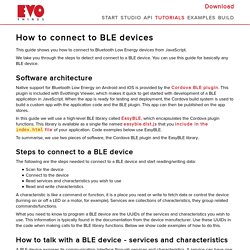
We take you through the steps to detect and connect to a BLE device. You can use this guide for basically any BLE device. Software architecture. BLE pairing vs. bonding. Bluetooth Basics. Bluetooth Low Energy Blog & Tutorials - Novel Bits. Ellisys Bluetooth Video 5: Generic Attribute Profile (GATT) Introduction to Bluetooth Low Energy. Bluetooth Technology Website. IoT Penetration Testing and Exploitation training - 2018. After tons of research and conducting 100+ IoT device pentests so far, we have put a training together for 2018 which will teach you how to pentest IoT devices.

"Offensive IoT Exploitation" or "Practical IoT Exploitation" is an IoT hacking class where we take an offensive approach to break the security of so-called "smart devices". It's a 3-day action packed class covering a number of topics including Embedded Device Hacking, Firmware Reverse Engineering, Binary Exploitation, Radio - BLE and ZigBee exploitation and more. The training puts special emphasis on learning-by-doing, which means that in the three days, you will get a chance to attack and pwn various real-world devices through the skillsets taught by the instructor. There will be no hand-holding, and this class is not for the ones who don't want to perform the exercises in class. Day 2 is where things start getting hardcore. Finally, the Day 3 contains everything that you need to attack devices remotely!
Another: The Practical Guide to Hacking Bluetooth Low Energy. Bluetooth, as we know, is one of the most popular and widely used wireless technologies in today’s world.

With the rapid growth of IoT accelerating development in Bluetooth technology, constant efforts are being taken by the Bluetooth Special Interest Group (SIG) to increase the transfer speed with a maximum focus on beacons, healthcare entertainment, and fitness. Bluetooth Low Energy (BLE) is a part of the Bluetooth 4.0 specification which additionally also includes Classic Bluetooth and Bluetooth High Speed Protocols. Compared to classic Bluetooth, BLE is intended to use lesser power while maintaining similar communication range. BLE is an "always off" technology and only transmits short amounts of data when required. Developer Studio. The Bluetooth Developer Studio application (“Software”) is provided to you conditioned on your acceptance of the following terms.
If you use the Software, you accept these terms. If you do not accept the terms, do not use the software. Bluetooth Low Energy - Part 1: Introduction To BLE. The world of wireless devices is rapidly spreading day by day. Ever since the invention of radios, different companies and research centers have had the same goal outlined for their engineers and scientists: create the most efficient, the most successful, and hence - the top selling radio module on the market. What defines a great radio module is not always easy to define, it usually depends of the task which the module has to solve. In some situations, we need to send big chunks of data over a wireless network, in which case we usually don't ask for the energy consumption.
In other situations, we have small portable devices which notify us of some occurrence, these devices use a battery for power, so the radio modules have to be as energy efficient as possible. When we are talking about energy efficient radio modules, which can still send a suitable amount of data at a very cheap cost of energy consumption, one radio technology stands out: Bluetooth Low Energy. Bluetooth Low Energy Scanning and Advertising- SCAN interval and SCAN Window. This workshop is a detailed description of how to use the advertising and scanning features of the TI BLE-Stack. All tasks in this lab session are targeted to be completed within a 2h time frame. You should have an intermediate level of knowledge of the C programming language as well as experience with embedded software development to be able to complete the tasks. ESP32 Bluetooth Low Energy (BLE) on Arduino IDE. The ESP32 comes not only with Wi-Fi but also with Bluetooth and Bluetooth Low Energy (BLE). This post is a quick introduction to BLE with the ESP32.
First, we’ll explore what’s BLE and what it can be used for, and then we’ll take a look at some examples with the ESP32 using Arduino IDE.